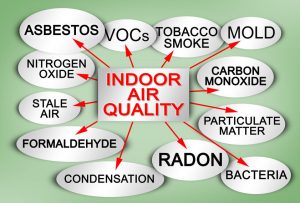It’s important to stay on top of the EPA’s (Environmental Protection Agency) latest reports on indoor air quality, and to ensure customers are taking necessary measures to ensure good, clean air in their warehouses, office buildings, and workspaces, especially in today’s climate. Learn more with these indoor air quality trends, and gain a greater understanding of the adverse health effects of poor IAQ.
The Importance of Indoor Air Quality
The quality of air inside indoor spaces can have profound effects on human health. It’s important to note that, according to the EPA:
- Americans on average spend 90 percent of their time indoors, in spaces in which concentrations of some pollutants are often two to five times higher than they are outdoors.
- People who are most adversely affected by indoor pollutants, such as very young children, older adults, and people with cardiovascular or respiratory diseases, tend to spend the most time indoors, exacerbating the problem.
- Indoor concentrations of certain pollutants have increased in recent decades due to factors such as energy-efficient building construction (when it lacks sufficient mechanical ventilation to ensure adequate air exchange) and increased use of synthetic building materials, furnishings, personal care products, pesticides, and various household cleaners.
Pollutants of Concern
Typical pollutants that can have major negative impacts on indoor air quality include:
 Combustion byproducts like carbon monoxide, environmental tobacco smoke, and particulate matter
Combustion byproducts like carbon monoxide, environmental tobacco smoke, and particulate matter- Radon, pet dander, mold, and other substances of natural origin
- Biological agents like mold
- Asbestos, lead, and pesticides
- Ozone from some air cleaners
- And volatile organic compounds resulting from a variety of products and materials
Although some pollutants originate outdoors, most come from sources inside buildings and affect indoor air quality adversely. Indoor sources include combustion sources like fireplaces and appliances, which can release harmful byproducts like carbon monoxide directly into an indoor space.
Other products like cleaning supplies, paints, and insecticides can also release chemicals into the indoor air degrading indoor air quality within a building. Building products too can be problematic whether from degrading materials releasing harmful fibers into the air, and even many new building materials can be harmful because of off-gassing.
Other Factors that Affect IAQ
Indoor air quality can also be affected by the outdoor climate, weather conditions, the air exchange rate, and occupant behavior. Air exchange rate, specifically, is affected by the building’s design, construction and operating parameters, and is a function of infiltration– meaning the way air flows through the structure by way of openings, joints, cracks, and spaces around windows and doors.
Weather conditions majorly influence the behavior of building occupants. For example the weather often dictates whether or not people open the windows, run air conditioning units or heaters, use humidifiers, and more. All of these factors play a role in overall indoor air quality. Also, certain climatic conditions can influence the presence of moisture and growth of mold if adequate ventilation is not achieved.
 IAQ Effects on Health
IAQ Effects on Health
The presence of indoor air pollutants can have profound effects on human health, causing symptoms such as:
- Eye, nose, and throat irritation
- Headaches
- Dizziness
- Fatigue
- Respiratory diseases
- Heart disease
- And some cancers
Furthermore, some indoor air pollutants produce clear cut health problems. For example,
- Radon is a known human carcinogen, and is the second leading cause of lung cancer.
- Short-term exposure to carbon monoxide in indoor settings can be lethal.
- Legionnaires’ disease, a form of pneumonia, has been linked to exposure to Legionella bacterium in buildings with poorly maintained HVAC systems.
- Many indoor air pollutants like dust mites, pet dander, cockroach allergens, and more, have been termed “asthma triggers,” meaning that some people may experience asthma attacks due to exposure.
Maintaining Good IAQ in Your Building
If air quality is an issue in your building, warehouse, or workspace, work with our expert team at Metro Services to test IAQ, diagnose any issues, and curate a plan of action to eradicate sources of pollutants adversely affecting your indoor air quality. Our thorough and professional indoor air quality services will ensure the air in your spaces is clean and safe to breathe.

